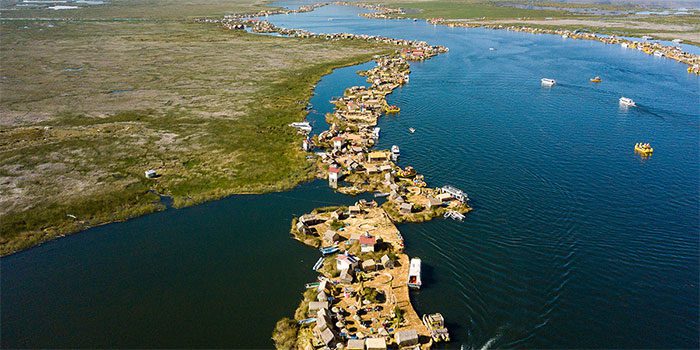Titicaca is a vast freshwater lake located on the border of Peru and Bolivia, renowned as the highest navigable lake in the world and home to a unique ecosystem of flora and fauna. However, what truly makes this lake “one of a kind” is the Uros people who live on floating islands on the lake.
Lakeside Titicaca sits at an elevation of 3,812 meters above sea level, perched atop the Altiplano in the Andes mountain range, making access to the lake quite challenging. Nonetheless, this has not deterred approximately 4,000 people who reside on the lake. They create their own islands using a type of reed that grows abundantly along the shores.
The original purpose of these islands was for defense. Over thousands of years of habitation in this region, the competition for abundant food and water resources led to continuous warfare. By living on floating islands, when threatened by enemies, the Uros people could simply move their island to another location and escape.

The Uros islands are “anchored” near the lake shore to prevent drifting too far away
The long time spent floating on the lake has led them to consider themselves the rightful owners of the vast waters, and they even claim that the Uros people have “black blood” because they do not feel the cold. Additionally, they refer to themselves as “Lupihaques,” meaning “Sons of the Sun God.”
The reed islands can last up to 30 years if properly maintained. Specifically, the Uros continuously add new layers of reeds on top while the submerged reeds begin to decay, a task that is considered part of their daily life.
Dry reed layers are woven and stacked upon each other to create buoyant islands capable of supporting substantial weight. A large island can support the weight of ten families, while smaller islands typically house 2-3 families.
It may sound primitive, but the life of the Uros people is more modern than we might think. They cook food on stones to avoid igniting the reeds. Furthermore, the Uros also use solar panels for lighting, watching TV, and charging phones.

Even without any modern cooking utensils, the Uros can still cook without igniting their home

Crafts made from reeds

Colorful traditional attire of the Uros
The primary food source for the island residents comes from fishing, hunting birds, as well as raising ducks and guinea pigs (a traditional dish in Peru). Similar to the lifestyle of indigenous people, the wildlife here is unique, with 90% of the fish found in Lake Titicaca not being found anywhere else in the world.
The Uros not only use reeds to build their homes but also to create furniture, boats, and handicrafts for sale to tourists.
In recent years, tourism has become a vital part of the Uros economy. They open their homes and welcome visitors from all over the world. Their unique lifestyle and the vastness of Lake Titicaca have made these floating islands an unmissable destination when traveling in Peru.
The way of life of the Uros is astonishing, yet it is gradually fading over time. Many still choose to live traditionally, rebuilding islands and fishing on the lake, but many young people are opting to leave and start a new life on the mainland.


















































